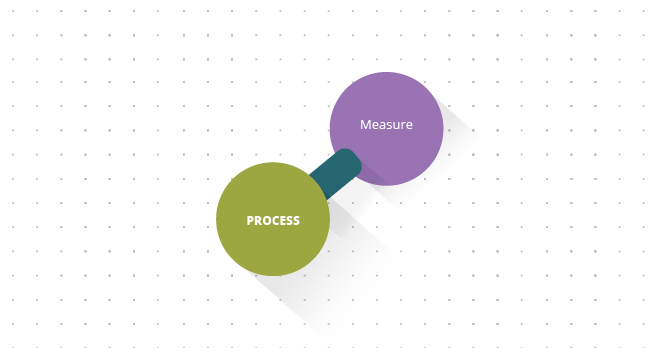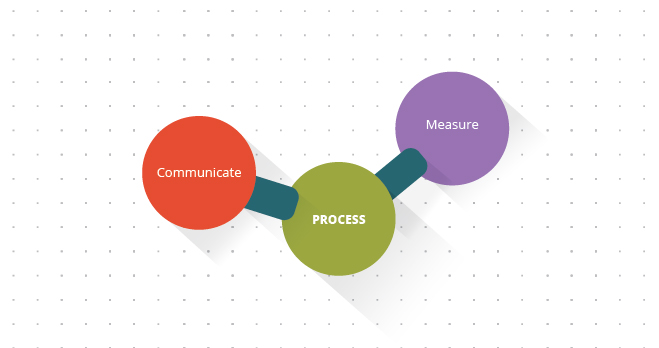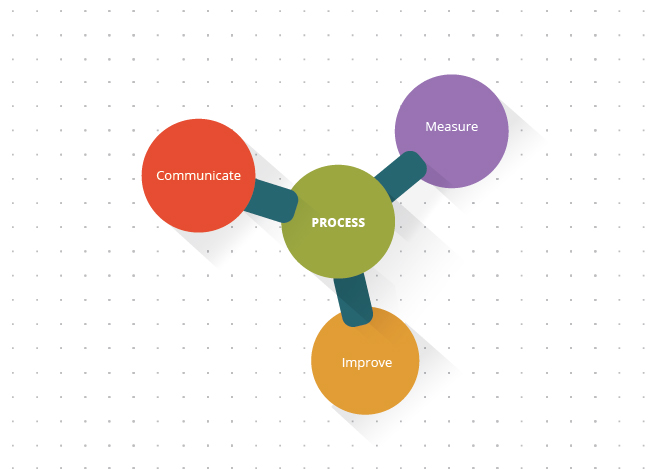Purposeful progress starts with a clear and inspiring vision that distinctly articulates a desired future. If that vision is powerful and clear enough, it can inspire people to take actions that will bring the desired future into reality. However, this case is rare and not easily repeatable. We can greatly increase the likelihood of achieving purposeful progress by leveraging the following three elements and tying them together with what is known as “process”:
- Measure
- Communicate
- Improve

Measure – A common saying goes: “what you measure is what you get.” Improvements occur more quickly and efficiently when you have the correct metrics and are committed to improving them. As humans, we like to keep score; just look at sports. How much fun would sports be if no one kept score? Would anyone watch? Would anyone even play?
Metrics provide a convenient method of determining whether or not we are improving, and are effective in motivating us to continue to improve. They also keep us focused, and become a powerful tool that we can use to assess what is successful and what is not.
Metrics create incentives for people to act. Therefore, the metrics that you select must produce the right incentives, and help drive you closer to your desired state. This isn’t always easy; you must think carefully about the impact of improving a metric, and watch for unexpected consequences. For example, if your goal is to achieve a higher level of quality, then measuring bugs and issues found prior to release at first sounds perfect. However, if you measure those numbers, you incentivize people to create bugs so they can be found easily, which is not creating a higher level of quality.
This isn’t to say the people creating bugs are the problem, just that a poor metric can and will incentivize unproductive behaviors. Instead, focus on something stronger, such as issues found after release, or issues reported by end users. These assessments create a stronger incentive that is much harder to manipulate, and is aligned with the ultimate quality vision.
For instance, Uber was recently forced to re-evaluate the metrics they base their business practices on when former U.S. Attorney General, Eric Holder, led an investigation into the company’s failings to police reckless behavior. One of Holder’s primary suggestions was for Uber to review metrics relating to the workplace culture, rather than simply revenue. This included diversity, responsiveness to employee complaints, employee satisfaction, and compliance. These metrics would be a critical part of performance reviews for senior leaders, creating new incentives for them to create a more positive company culture focused on improvement.
Once you have determined which metrics will have the most impact, you need to consider whether you want a singular point in time response, or a trend. A point in time is valuable for specific data points, but it doesn’t offer anything to indicate which direction your quality is going. Trend metrics can be a powerful way to ensure that improvements are being made, and they can help to level out situations. Taking action to improve is critical for making progress, but planning ahead based on metrics will help ensure you’re on the right track.

Communicate – Perception equals reality when it comes to clients and internal stakeholders. Because of this, we must manage and influence those perceptions, crafting the story in a way that effectively communicates the value delivered. Since we can’t assume that they recognize the same value we do, we need to proactively and regularly communicate. For example, delivering enormous value to a client (at least, enormous in your own mind), only to have the client fire you due to a disparity in the perceived value, implies that you need to improve communication with your clients.
Changing perceptions requires trust; the client and internal stakeholder will only believe your story if they trust you. Facts that are backed by metrics can be a great way to reinforce trust, and to create a more believable story. Likewise, we have to be sure we are authentic and accurate. A story about value that was never delivered or value that was exaggerated may have some success, but ultimately, the truth will be revealed, and will damage credibility and trust between the company and its clients. To prevent this from happening, we must make sure that the facts are always communicated accurately. This isn’t about creating spin, but rather about communicating a story that is both authentic and factual.
When a story is created in the absence of communication, it will likely deviate from the story we would tell because the client lacks accurate information. Once a story has been created, it is difficult to change, which means that you need to communicate quickly and precisely before the client frames the story for themselves. This also means that you need to constantly be thinking about how the client is perceiving performance, and to be proactive about it. It is also a good idea to tell the story in segments over time, so that it correlates with the pace at which information is learned by a client, gradually creating a compelling narrative when it is finally strung together.
The story should be truthful, of course, and should include reasons that explain why any mistakes may have been made. Owning up to a mistake with an explanation as to why it happened and how it will be prevented next time, frames a much more accepted story than simply saying “we made a mistake”.

Improve – Complacency is the enemy of success. Today, the rate of change in technology is difficult to keep up with. Whatever is known as a best practice today will become a common practice by tomorrow.
A prime example of this is the fall of Kodak. Once considered to be one of the world’s most valuable brands, Kodak was a powerhouse in the film industry. However, their complacency in producing film and film cameras prevented them from taking advantage of the shift towards digital photography. With digital replacing film and smartphones replacing cameras, the tides were quickly turning. While Kodak did eventually invest substantial time and money into digital technologies, their shift in focus was too late to overcome such a disruptive change in the marketplace.
Because this is the case, we need to keep constantly changing and improving. However, if this is arbitrary and there are no metrics, then you have no basis from which to improve. You can set fuzzy goals – for example, improving quality – and will likely succeed, but not in a specific, constructive way. However, if you can be clearer with a metric/series of metrics, then ultimately the focus, alignment, and overall results, will improve exponentially.
Improving over time creates trends that are powerful tools for stories. For example, telling a client that we have improved X-measure by Y% a quarter for six quarters in a row, is a powerful way of saying that we are continually growing. Trends build confidence that you are on the right track.
To improve effectively, find people who are committed to driving themselves to become better. If people feel as though the measurements and improvements are controlling them, they will be negatively motivated. The key is to make it clear that improvement is needed, and the metrics will provide facts around which improvement opportunities exist, along with details on how we are improving over time. With that level of clarity, people will be more apt to willingly choose to commit to making improvements.
Measuring, Communicating, and Improving. These are the three actions that have consistently worked together to make a vision come true, by working in conjunction with process.
Strong metrics provide a means to improve and advance what is delivered, along with compelling data to backup and reinforce communications. This only works, however, if each metric and each improvement builds on each other. Each piece needs to be part of a larger whole, and this is where process comes in: it is the glue that ties everything together.
For example, at ITX, a higher level of quality was something that we set as a goal to improve and continue to improve. We began by defining a number of metrics – for example, the intercept rate (the number of issues our clients found verses the number of issues that we found). We then measured the differences for a quarter, and set a goal that was slightly higher than what we were currently getting. After a few quarters, we could see that we were indeed achieving this new, higher level, so we raised the bar again.
We continue to do this in a way that allows everyone to have a part in setting these goals, and is committed to accomplishing them. By involving everyone and communicating to them why this is important, they offer their commitment in return, which is what drives results. As is outlined, simply measuring our quality is not enough, and we need to communicate that policy effectively. To this end, we craft quality reports for our clients, sharing the results and our interpretations with them. The numbers generally show that we have been improving quality quarter over quarter for several years now.
Metrics, communication, and improvement, when focused together, put you on a path towards achieving a desired outcome: momentum. This coupled with a positive feedback loop, generates results your team members, clients, and stakeholders are aiming to achieve.
References:
Kotter International (2012, May 2). Barriers to Change: The Real Reason Behind the Kodak Downfall. https://www.forbes.com/sites/johnkotter/2012/05/02/barriers-to-change-the-real-reason-behind-the-kodak-downfall/#3058f4ee69ef
Polina Marinova (2017, June 13). 10 Things You Need to Know From Eric Holder’s Uber Report. http://fortune.com/2017/06/13/uber-internal-investigation-results-public/
Why ITX. Higher Level of Quality.
Sean Flaherty (2016, March 28). Momentum.



